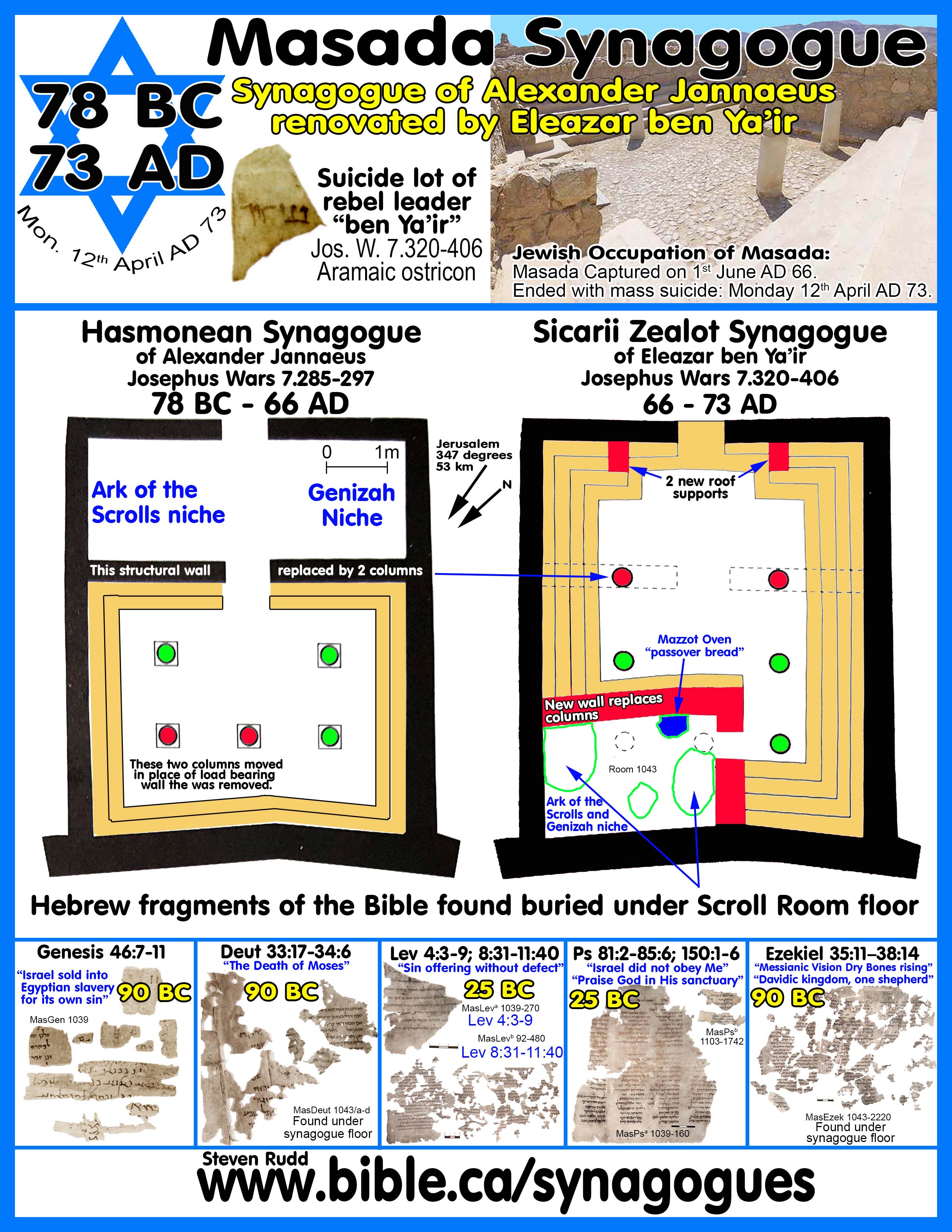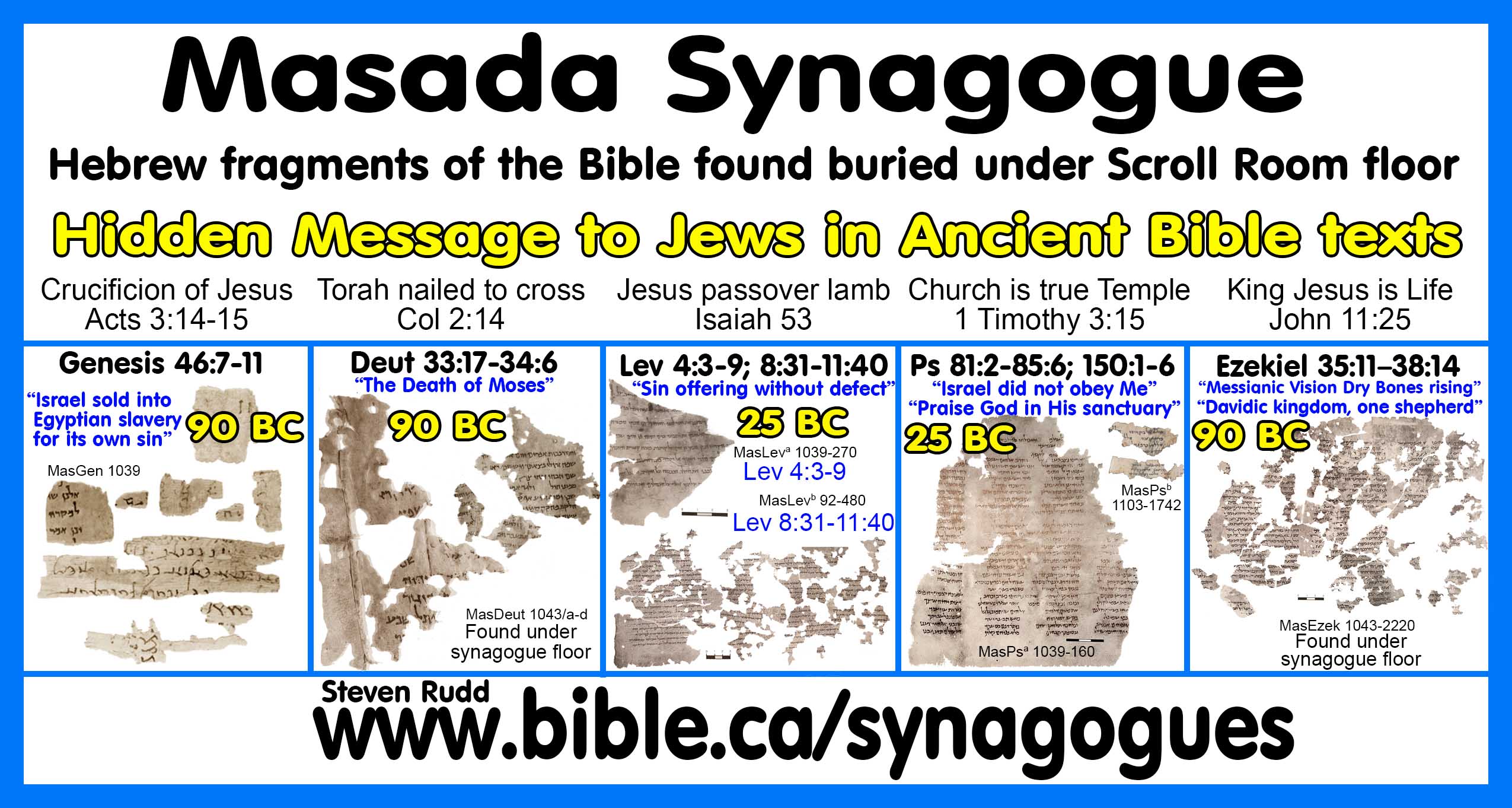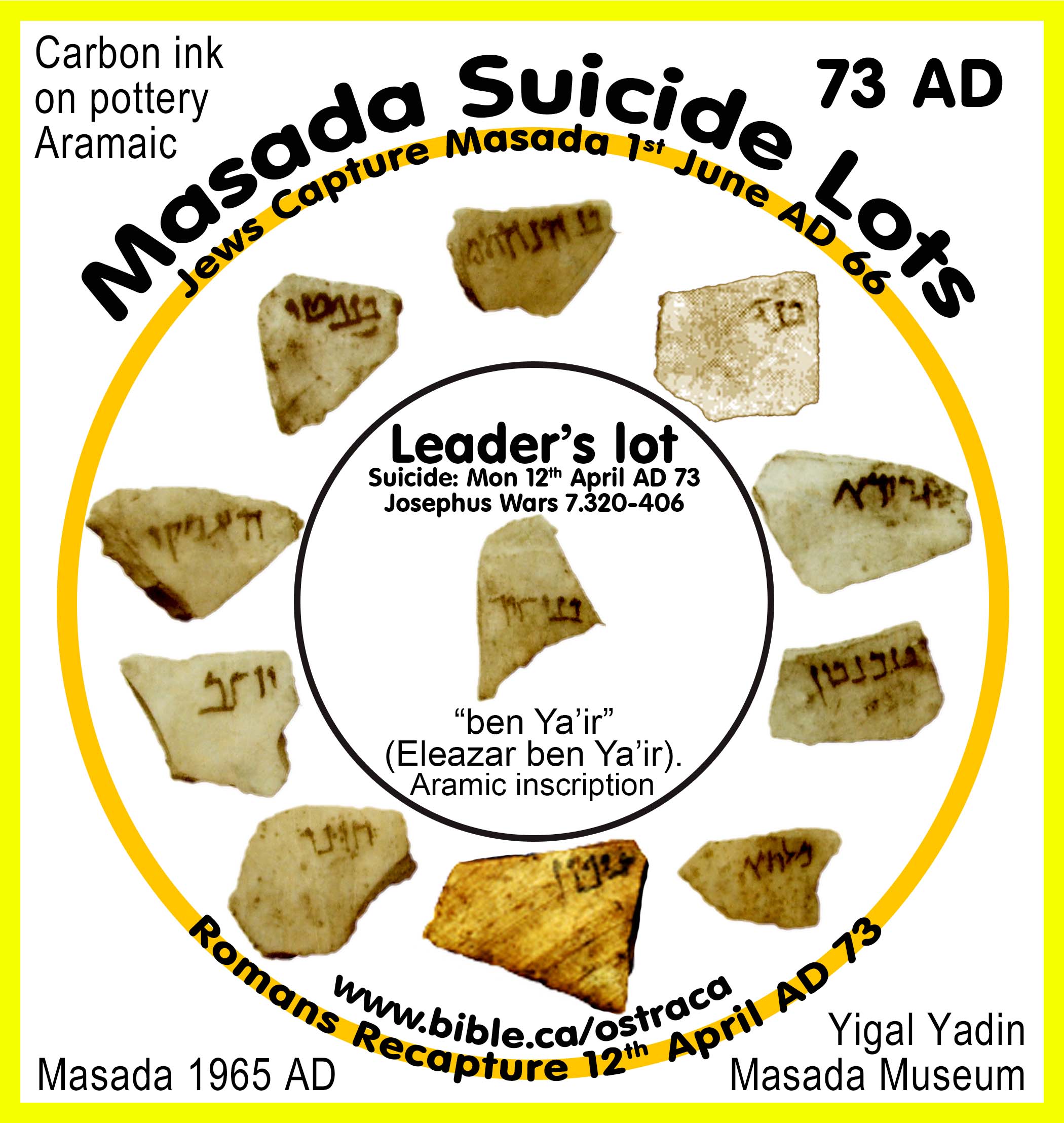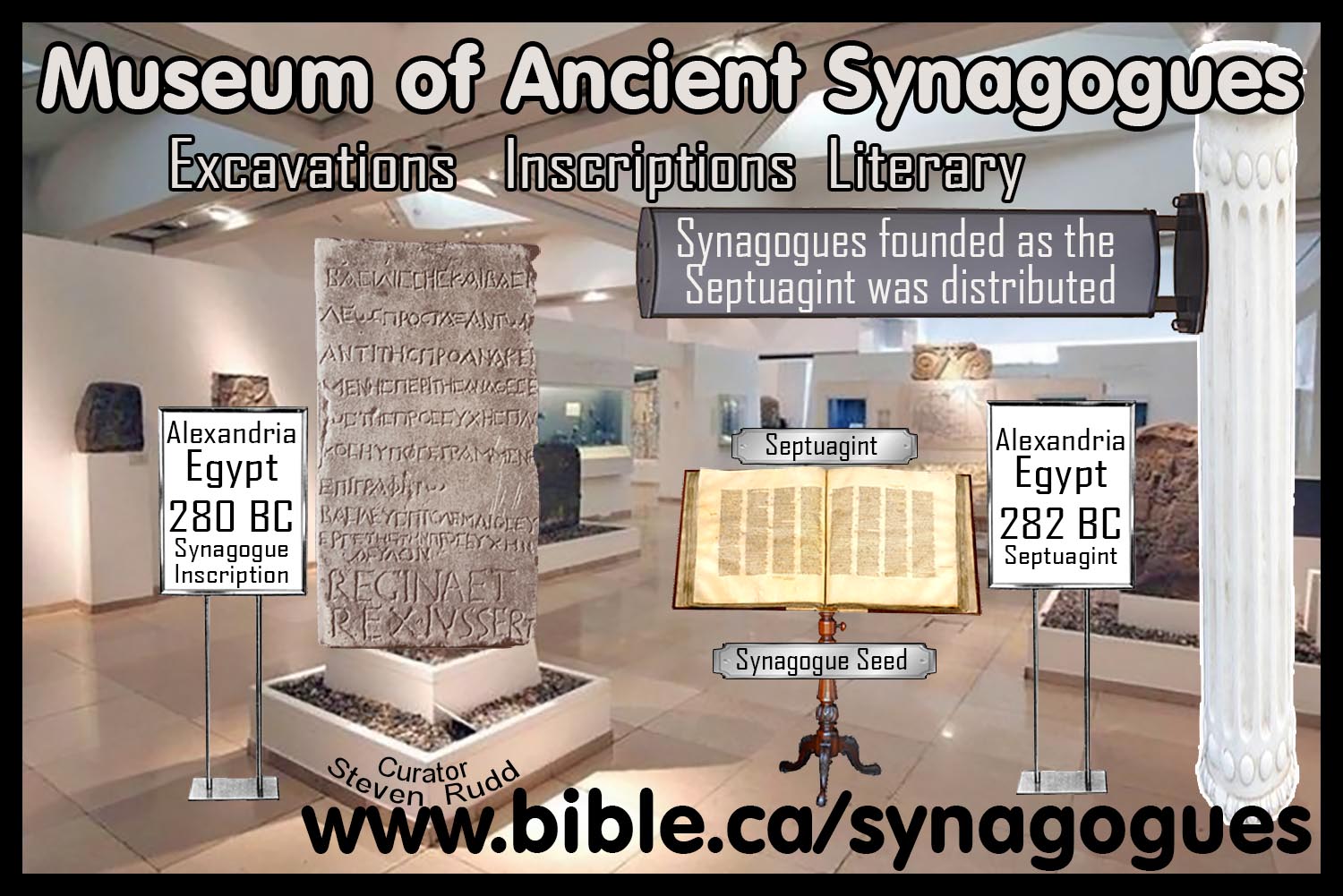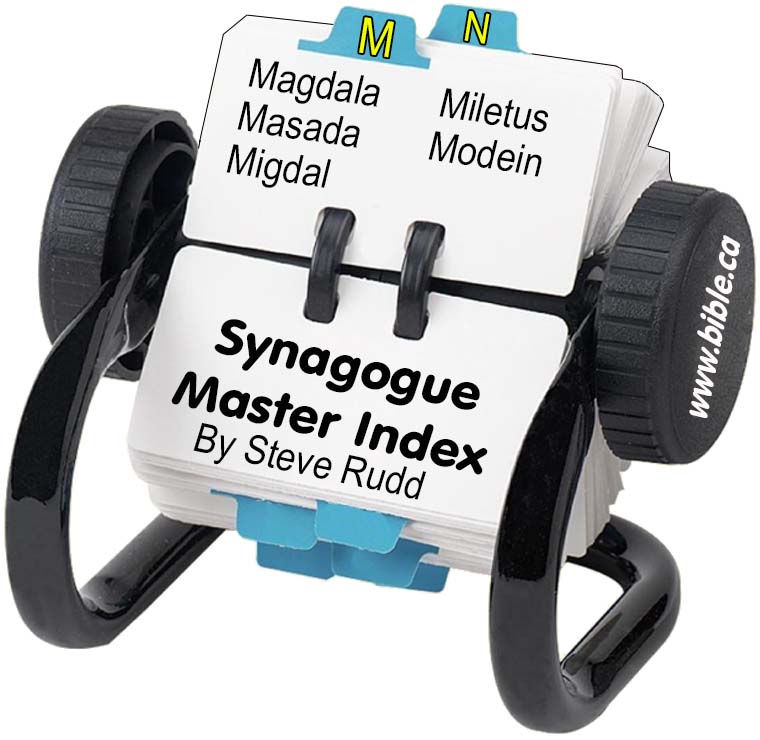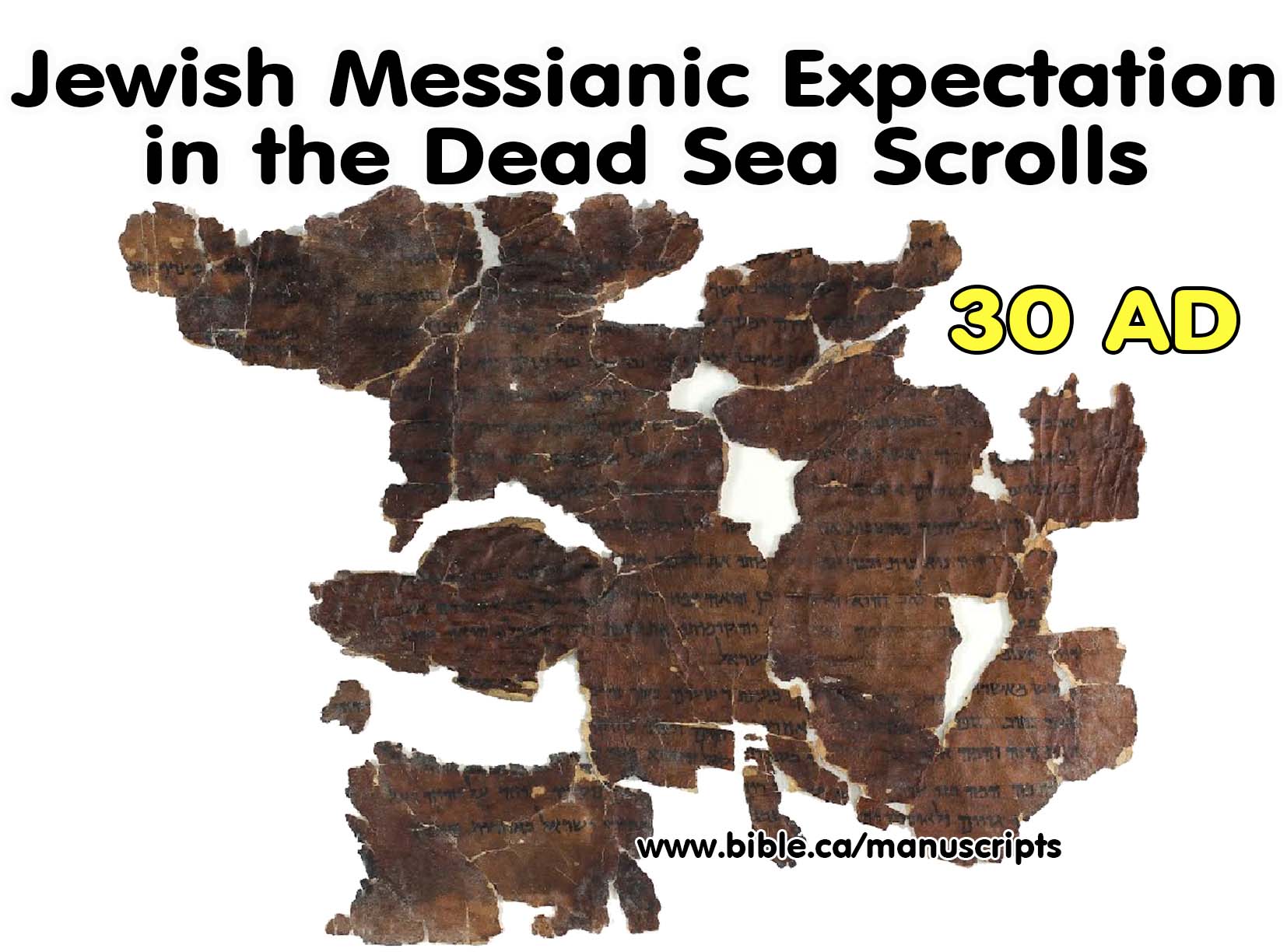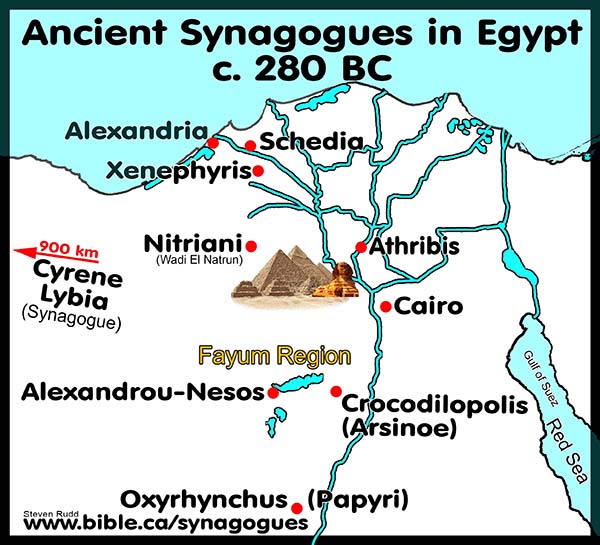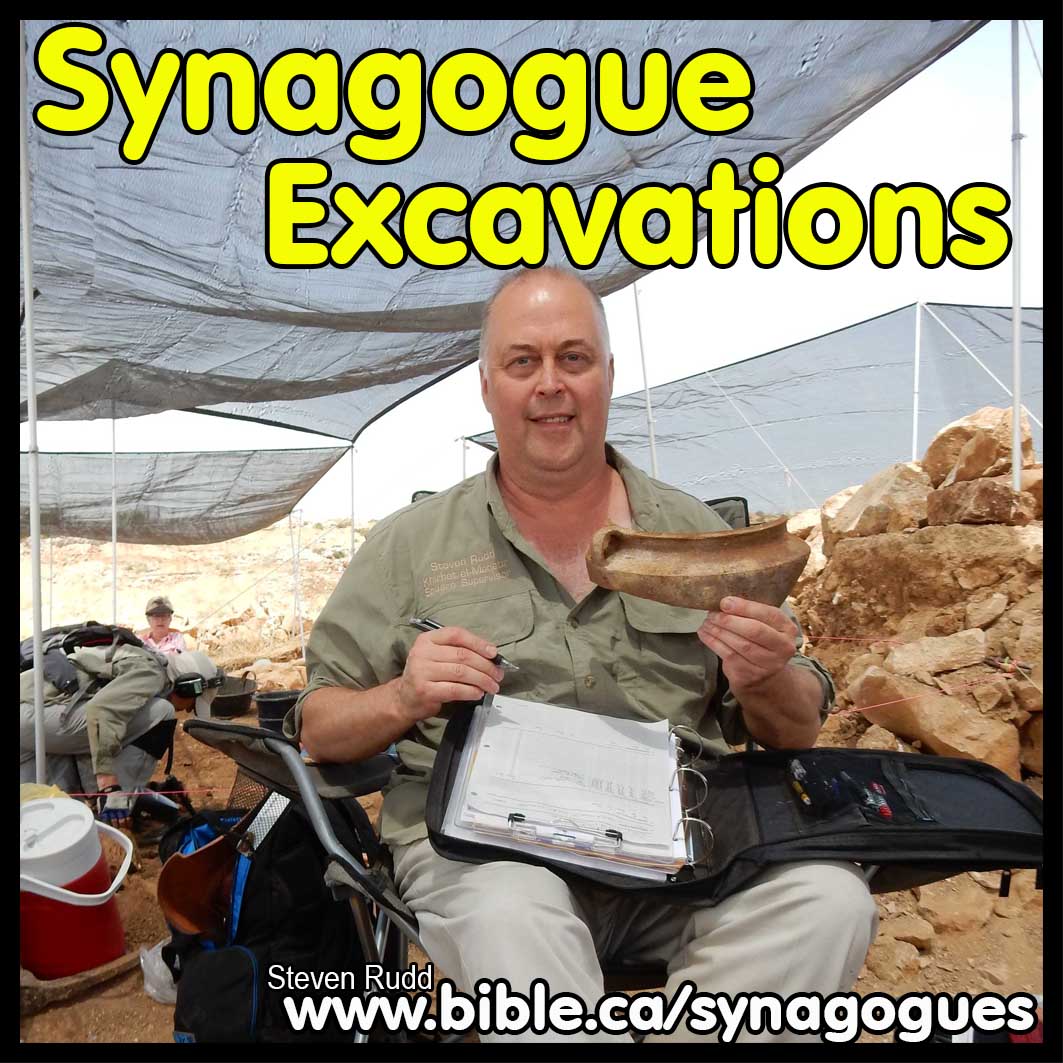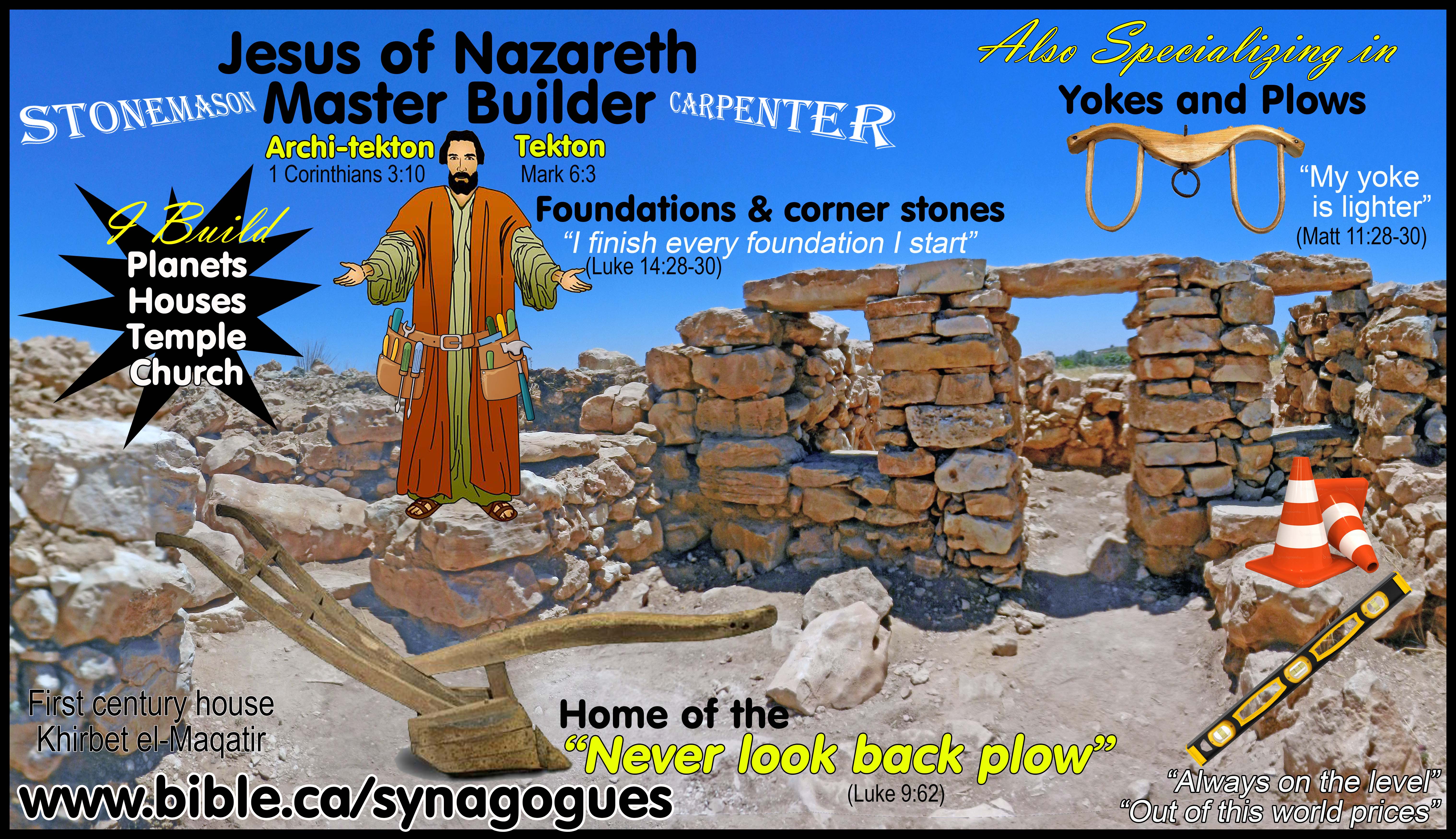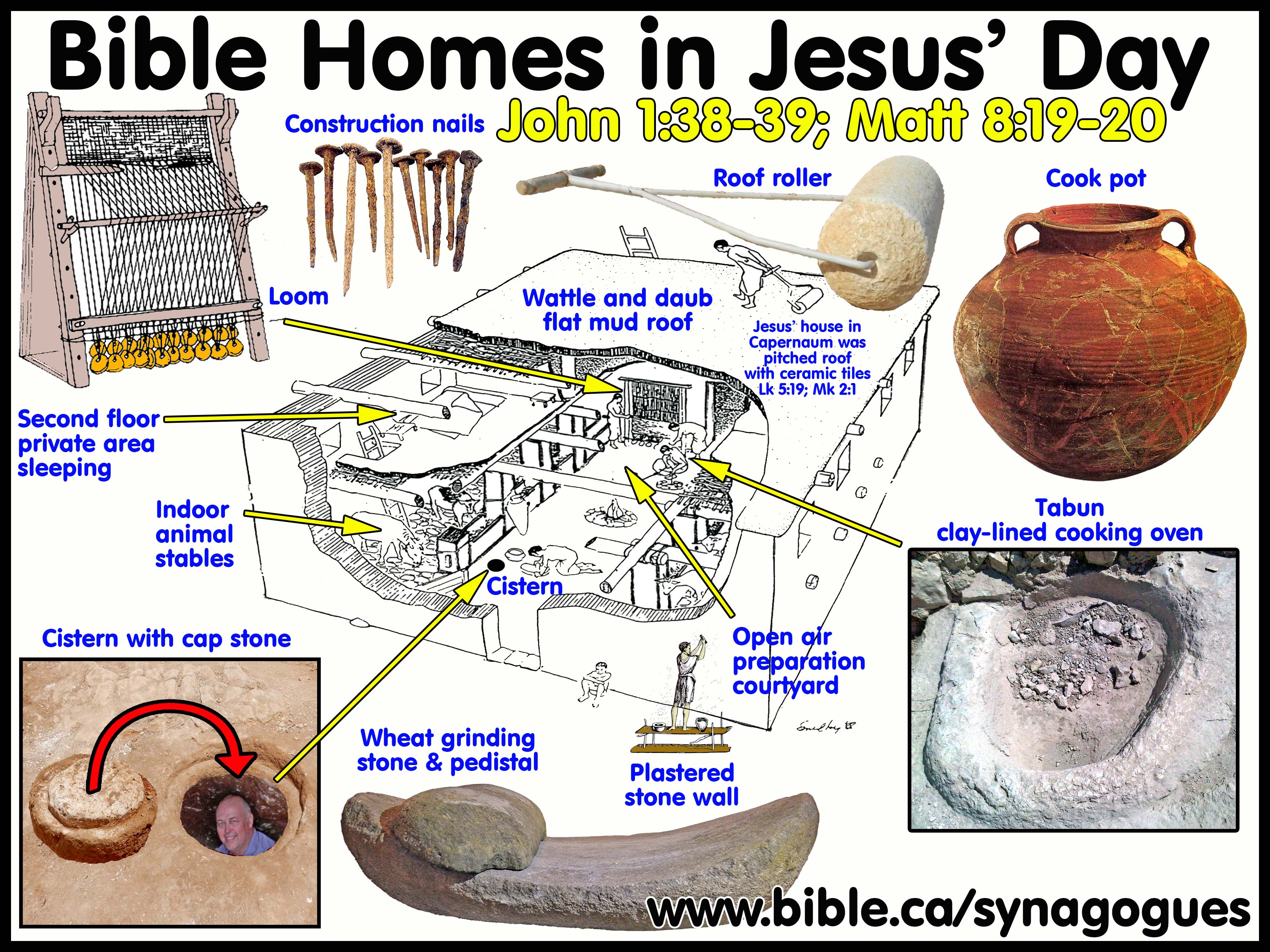First Century Synagogue Top Plans: Masada 78 BC
Archeological Excavations of Oldest Synagogues in the world
|
Masada 78 BC |
Click on photos for high resolution
Introduction:
1. Masada was founded by Alexander Jannaeus (103-76 BC) probably in 78 BC
a. Masada (Aramaic “metsad” = fortress)
2. There are two occupation phases for the synagogue at Masada: 78 BC – 73 AD
a. 78 BC - 66 AD: Hasmonean Synagogue of Alexander Jannaeus: Josephus Wars 7.285-297
b. 66 - 73 AD: Sicarii Zealot Synagogue of Eleazar ben Ya’ir: Josephus Wars 7.320-406:
3. Jewish Occupation of Masada:
a. Masada Captured by the Jews on 1st June AD 66.
b. Ended with mass Jewish suicide: Monday 12th April AD 73.
4. The 7 year First Jewish War:
a. Started at Caesarea synagogue: Sabbath 17th May AD 66.
b. Ended with mass suicide at Masada: Monday 12th April AD 73.
5. Exactly 40 years from Crucifixion to Mass Suicide at Masada:
a. Masada Mass Suicide occurred on Monday 12th April AD 73 = 15th Nisan = 15th Xanthicus: “Those others were nine hundred and sixty in number, the women and children being withal included in that computation. This calamitous slaughter was made on the fifteenth day of the month Xanthicus [12th April AD 73].” (Josephus Wars 7.400–401)
b. Masada fell 40 years (one Generation) to the very day, after Jesus was crucified: “Truly I say to you, all these things will come upon this generation. “Jerusalem, Jerusalem, who kills the prophets and stones those who are sent to her! How often I wanted to gather your children together, the way a hen gathers her chicks under her wings, and you were unwilling. “Behold, your house is being left to you desolate!" (Matthew 23:36–38)
c. The mass suicide corresponds to the Sabbath day when Jesus was lying in his tomb on 15th Nisan AD 33.
6. The synagogue was renovated by the rebels of the first Jewish was and their leader, Eleazar ben Yair when they first arrived after Gamla and Ephraim (Jn 11, Kh. Maqatir) were captured and destroyed by the Romans in 73 AD.
a. 12.5x10.5 rectangular
b. Four tiers of benches with mud plaster abut the outside walls.
c. Two rows of columns: 3 columns on south row, 2 columns on north row
7. Fragments of Genesis, Deuteronomy, Leviticus, Psalms and Ezekiel were found in the room in the northern corner of the Synagogue.
a. These are some of the oldest known Bible text in the world.
b. They date to the same period as Qumran.
8. Also found was one of 9 copies of the Songs of Sabbath Sacrifice (Angelic Liturgy) which is a first century songbook widely used in the synagogues.
a. See also: Singing in Synagogues: Non-Instrumental Acapella Responsive Singing
b. One copy was found at Masada and 8 at Qumran.
c.
Angelic Liturgy was a prototype for the book of
Revelation.

A. Scholarly Precision in dating the fall of Masada to Monday 12th April AD 73:
1. Parker and Dubberstein are the current scholastic standard for Jewish to Julian dates conversion today.
2. In 1971, Parker and Dubberstein published their landmark work in fixing past chronological dates which were consistently in error.
a. Any book published before AD 1971 will in error when converting Bible dates and those used by Josephus of about three weeks.
b. Almost all dates in most published scholastic works have an error of about three weeks.
3. The Bible Only Revelation Commentary by Steven Rudd (2018 AD) utilizes the Parker and Dubberstein Hebrew to Julian date conversion tables.
a. Babylonian Chronology: 626 B.C. - A.D. 75, Richard Anthony Parker, Waldo H Dubberstein, 1971 AD
b. See also: Online Parker and Dubberstein date converter.
c. Special thanks to Rodger Young who has been an invaluable help in this matter.
4. Dating Example 1: Destruction of Jerusalem Temple on 10th Av AD 70
a. The Temple of Jerusalem was burned on 10th Av AD 70 and the correct Julian date according to Parker and Dubberstein is Monday 6th August AD 70.
b. However, Wikipedia (Notoriously inaccurate) many online websites (ie. Gary. J. Goldberg’s Josephus Chronology) and published scholastic Bible reference works incorrectly date the 10th Av to 29th August AD 70.
c. This means that the correct Julian date for 10th Av is 23 days (3 weeks) earlier than incorrectly recorded online and in Bible encyclopedias.
i. Correct: Monday 6th August AD 70 (Parker and Dubberstein)
ii. Wrong: 29th August AD 70 (23 days later than correct date)
d. Both Nebuchadnezzar and Titus burned the Jerusalem Temple on the exact same day of the year: 10th Av.
e. Modern Jewish Rabbis and Jewish Scholars generally reject Josephus as a corrupted fabrication of Christians and date the burning of the temple to Av 9, one day earlier than Josephus. Of course even Josephus noted that the Jews of the first century were “creeped out” that the 10th Av was the exact same day of the year that Nebuchanezzar burned the Solomonic temple in 587 BC.
5. Dating Example 2: Fall of Masada on 15th Xanthicus AD 73 = 15th Nisan AD 73.
a. Josephus records the mass suicide event: “Those others were nine hundred and sixty in number, the women and children being withal included in that computation. This calamitous slaughter was made on the fifteenth day of the month Xanthicus [Nisan].” (Josephus Wars 7.400–401)
b. Josephus says that Masada fell on 15th Xanthicus AD 73 (15th Nisan) and the correct Julian date according to Parker and Dubberstein is Monday 12th April AD 73.
c. Several Bible Encyclopedias use the incorrect date of 2nd May AD 73 for the fall of Masada and the mass suicide that Josephus says happened on 15th Xanthicus AD 73.
i. “This garrison was soon expelled by the Zealots, who held Masada until 2 May in the year ad 73, when it was finally conquered by the Romans.” (The Archaeological Encyclopedia of the Holy Land, Masada)
ii. “According to Josephus the end came on the 15th of Xanthicus, or May 2, a.d. 73” (ISBE, Masada, Volume 3, Page 276, 1988 AD)
d. This means that the correct Julian date for 15th Xanthicus AD 73 is 20 days earlier (3 weeks) than incorrectly recorded online and in Bible encyclopedias.
i. Correct: Monday 12th April AD 73 (Parker and Dubberstein)
ii. Wrong: 2nd May AD 73 (20 days later than correct date)
e. It is exactly 40 years from the crucifixion of Christ on 14th Nisan AD 33 to the end of the First Jewish War on 15th Nisan, when Masada fell. Jesus warned in Matthew 23:36–38 that “this generation” would be punished for rejecting Him as Messiah.
f. Jewish archeologists, modern Jewish Rabbis and Jewish Scholars generally reject Josephus as a corrupted fabrication of Christians and date the fall of Masada to AD 74. They reject there was a mass suicide at all and question many other elements based upon archeological interpretation between what Josephus reported and what the excavators discovered. In fact, there is no dissonance between Josephus and archeology. Such a revised date from AD 73-AD 74 may be motivated by a desire to disconnect the perfect synchronism of 40 years from the death of the Messiah and the final defeat of the Jewish nation.
B. Earliest Synagogue Occupation Date (SOD) = 78 BC
1. Excavation date: first century
2. Inscriptional date: none
3. Literary date: Josephus 78 BC
4. SOD computation system details: Excavation date + Inscriptional date + Literary date = SOD.
C. Synagogue Compass Orientation:
1. Orientation East or towards Jerusalem: No.
2. Compass headings:
a. Compass heading towards Jerusalem: 347 Degrees.
b. Distance to Jerusalem: 53Kilometers.
3. When an archeologist begins excavating a newly discovered synagogue, the first thing he does to determine if it is a first temple, pre-70 AD installation is determine the orientation.
a. If the synagogue points east it is not pre-70 AD but built after 200 AD.
b. If the synagogue is oriented towards Jerusalem it is not pre-70 AD but built after 200 AD.
4. See Orientation: Early Synagogues did not Point to Jerusalem
D. Bible and other Literary references:
1. Josephus writes that the site was first fortified by Alexander Jannaeus: 103-76 BC:
a. “Upon this top of the hill, Jonathan the high priest [Alexander Jannaeus: 103-76 BC] first of all built a fortress, and called it Masada; after which the building of this place employed the care of king Herod to a great degree” (Josephus, Wars of the Jews 7.285)
2. It is most improbable that a HIGH PRIEST would not build a synagogue on the summit of Masada.
E. The amazing story the Ancient Bible texts at Masada tell:
1. Can you decipher the message from God to the Rebel Jews who rejected Christ, from the Bible texts found at Masada?
a. 90 BC: Genesis 46:7-11: “Israel sold into Egyptian slavery for its own sin” (Crucifixion of Christ)
b. 90 BC: Deut 33:17-34:6 “The Death of Moses” (Torah nailed to the cross: Col 2:14)
c. 25 BC: Lev 4:3-9; 8:31-11:40 “Sin offering without defect” (Jesus, the sinless Passover lamb: Isa 53)
d. 25 BC: Ps 81:2-85:6; 150:1-6 “Israel did not obey Me” “Praise God in His True sanctuary” (The church is the true temple of God now)
e. 90 BC: Ezekiel 35:11–38:14 “Messianic Vision Dry Bones rising” “Davidic kingdom, one shepherd” (Jesus is the resurrection and the live and the messianic branch of David who is sitting right now in heaven.)
2. "In addition to the two biblical scrolls found in the synagogue, several others—including sections of Psalms, Genesis, and Leviticus—were uncovered in various spots throughout the site. In addition, scrolls that were not part of the Hebrew Bible were also uncovered at Masada, including the Hebrew original of the Wisdom of Ben-Sira, a fragment of the book of Jubilees, and a fragment of the Hebrew Song of the Sabbath Sacrifice. All books of the Bible were at this point written and transmitted in scroll form. While scrolls—written on parchment—are rare finds, the dry climate of the Judaean Desert allows for the remarkable preservation of organic materials, as was the case with the Dead Sea Scrolls found at Qumran." (Lexham Bible Dictionary, Masada, 2016 AD)
3. "final reports of the Masada excavations led by Professor Yigael Yadin from 1963-1965. … In his excavations at Masada during the 1963/64 and 1964/65 seasons, Yadin and his team discovered fifteen manuscripts, fourteen inscribed on parchment with the Jewish square script and one written on papyrus in the Palaeo-Hebrew script: Fragments of Biblical Scrolls: Genesis 46:7-11. (MasGen) There are minor variants with MT; Leviticus 4:3–9. (MasLev) Both the orthography and the readings agree with MT; Leviticus 8:31–11:40. (Mas-Lev) The text belongs to the Masoretic textual tradition as its readings … section system are identical to MT; Deuteronomy 33:17–34:6. (MasDeut)The text agrees with MT; Ezekiel 35:11–38:14. (MasEzek) generally agrees with MT; Psalms 81:2–85:6. (MasPs)The text is nearly identical with MT… Both MT and MasPs present the same order of Psalms 81 through 85; Psalms 150:1–6. (MasPs) Almost the entire text of Psalm 150, which accords with the reading of MT except for a couple of orthographic variants, is present on the fragment. A large blank space on the parchment, located to the left of the text, indicates that this Psalm was the last on the scroll, in harmony with MT but at variance with the Psalms Scroll from Cave 11 and the Septuagint. Fragments of Apocryphal Texts: Genesis Apocryphon (MasapocrGen); Joshua Apocryphon (MasapocrJosh); Jubilees or Pseudo-Jubilees; Songs of the Sabbath Sacrifice (MasShirShabb); The Ben Sira Scroll From Masada, Hebrew version" (Masada VI Yigael Yadin Excavations 1963–1965 Final Reports, Donald W. Parry, Near Eastern Archaeology, 63:1-4, p114, 2000 AD)
4. Excavations at Masada in 1963–1965 uncovered the remains of fourteen scrolls, including biblical, sectarian and apocryphal texts. They date to sometime before A.D. 73, when the Romans stormed the fortress, and provide further evidence that the Hebrew text had become unified by the first century A.D. Some of the more interesting biblical texts are: • A very fragmentary Psalms scroll containing parts of Psalms 81:3 (ET 81:2) to 85:10 (ET 85:9) (see fig. 6.8). The text of this scroll is identical to the MT in both content and spelling. • A fragment of Leviticus containing the second half of eight lines from Leviticus 4:3–9. It is identical to the MT in content and spelling. • A fragmentary Leviticus scroll containing Leviticus 8–12. The text of this document is identical to the MT even in respect to the traditional divisions of the “open” (where the line is left open after a Hebrew sentence) and “closed” (where another Hebrew sentence finishes up the line) sections. • A scroll of Ezekiel and one containing the final two chapters of Deuteronomy. These texts largely reflect the traditional MT, but a few readings in the Ezekiel scroll differ slightly from the MT. • A copy of Psalm 150, seemingly at the end of a manuscript, which suggests that the Psalms at Masada may have been ordered similarly to the canonical psalter. The Masada manuscripts are written in Hebrew square script and are virtually identical to the MT (in wording as well as the divisions of the lines), except for slight differences in the Ezekiel text. (A student’s guide to textual criticism of the Bible, Manuscripts at Masada, P. D. Wegner, p152, 2006 AD)
5. "In addition, scrolls that were not part of the Hebrew Bible were also uncovered at Masada, including the Hebrew original of the Wisdom of Ben-Sira, a fragment of the book of Jubilees, and a fragment of the Hebrew Song of the Sabbath Sacrifice." (Lexham Bible Dictionary, Masada, 2016 AD)
6. “Masada provides us with the earliest Greek and Latin papyri, ostraca and tituli picti from Palestine. There are also solitary pieces of inscribed parchment and leather, some graffiti and stamps. A comparison with the Hebrew and Aramaic material from Masada shows that the latter includes all the main varieties (viz. papyri, ostraca and tituli picti) with the exception of graffiti: there are no Aramaic or Hebrew graffiti on walls on Masada. Where does all this material come from? Was it written on the site or brought there? We are on firm ground in the case of the tituli picti: the Latin inscriptions (as well as a few bilingual items) are inscribed on imported products, while the Greek ones were, or at least could have been, locally inscribed. The ostraca were probably all written on the site: the Latin ones by soldiers of the garrison stationed on the fortress; the Greek ones, like the Aramaic and Hebrew ostraca, by Jews. It is with the papyri and parchment that the situation becomes somewhat more complicated. The biblical scrolls and other Jewish sacred writings on both parchment and papyrus must be treated separately: they could all have been written elsewhere and then brought to Masada. The Latin papyri (including no doubt the undecipherable piece of inscribed leather no. 738) all belong to the Roman forces, whether written by its soldiers or received by them. Our problem begins with the Greek papyri: their illegibility makes their analysis very difficult. Even if written by Jews — like the rest of the Greek material — they could have been written elsewhere as suggested by the fragments of at least three letters among them (nos. 741; 745; 746) as well as by the total absence of documentary papyri in Aramaic and Hebrew. One could assume the unavailability of papyrus on Masada at least during the Jewish occupation were it not for the existence of a Jewish writ of divorce in Aramaic from Wadi Murabba'at dating from "the year six in Masada". Milik thought that the date referred to the era of the provincia Arabia. However, as Yadin (1965: 119, n. 112; 1971: 1880 already saw, that would assume a Jewish presence on Masada in 111/2 C.E. — an assumption both unsupported by archaeological evidence and unwarranted by historical considerations.” (Masada VI Yigael Yadin Excavations 1963–1965 Final Reports, Donald W. Parry, Near Eastern Archaeology, 63:1-4, p1, 2000 AD)
7. Most of the written material discovered on Masada' emanates from Jews. This is certainly true of the Aramaic and Hebrew ostraca and jar inscriptions as well as of the biblical scrolls and other sacred texts. However, almost all the Greek texts, with the exception of the very few remains from the Byzantine period, were also written by Jews. This conclusion is based on two considerations: 1) much of the material can be safely traced back to Jews, while no item can be related to non-Jews; 2) a comparison with the Aramaic and Hebrew evidence furnishes significant parallels and similarities. The key to the Jewish origin of the Greek finds from Masada lies in the nomenclature. Some of the names are patently Jewish names written in Greek characters, e.g. Salome (nos. 777; 891-4), Simon (nos. 896-9), and Judas (nos. 741; 900). Others, although genuinely Greek, appear alongside Jewish names: e.g. Zenon appears with Bar Jason and Shabyo — nos. 878-81; 883-9 — written in Jewish characters, Lykias and Aminias with Lazar (no. 779) and Abaskantos with Judas (no. 741). Thus the context implies that these too belonged to Jews. Of the few remaining names, some of them are known from other contexts to have been borne by Jews, e.g. Kosmos (no. 773), while others, like Diadochos (no. 786), although hitherto unattested for Jews, could still be borne by them." (Masada VI Yigael Yadin Excavations 1963–1965 Final Reports, Donald W. Parry, Near Eastern Archaeology, 63:1-4, p2, 2000 AD)
8. DATING: “One more point needs to be considered. As stated. MasDeut, like MasEzek, was discovered under the floor of the synagogue in a cavity which Yadin termed genizah.18 In Jewish tradition, the term defines a chamber in a synagogue set aside for the storage of 'holy books', such as Torah scrolls, which had become unfit for public use, either because their text was found to be faulty to an excessive degree or because they were tattered beyond repair.' To prevent the desecration of such unusable, but still considered 'holy', scrolls and books they were deposited in such a storage room, and eventually buried in the grave of a rabbi or a community member of distinction. Now, if those pits under the floor of the synagogue served indeed as a geniah, this would imply that MasDeut had deteriorated to a considerable degree, and was therefore put away in that cavity. This would suggest that the scroll had been in use for a considerable length of time prior to the fall of Masada in 73/74 CE, and support the dating of MasDeut by palaeographic criteria to not later than the beginning of the Herodian era.” (Masada VI Yigael Yadin Excavations 1963–1965 Final Reports, Donald W. Parry, Near Eastern Archaeology, 63:1-4, p58, 2000 AD)
F. Occupation history:
1. “A natural rock fortress on the western shore of the Dead Sea. Josephus (War VII, 285) states that a fortress was built at Masada by ‘the high priest Jonathan’. This could have been either the brother of Judas Maccabaeus or Alexander Jannaeus, whose Hebrew name was Jonathan. The place is still referred to as a fortress when, in 42 BC, it was taken by Malichus, an antagonist of Antipater, Herod’s father (Josephus, War I, 237). Herod used Masada as a safe retreat for his family in 40 BC, before leaving for Rome (Josephus, Antiq. XIV, 280–303; War, I 238, 263–6). After his return he built a completely new fortress on the site. Josephus describes the new fortress in minute detail (War VII, 280–300) and it seems unlikely that he did not visit the site before the Roman siege, though some scholars believe that he did not. Little is known of Masada in the years immediately following Herod’s death, but it is most improbable that it was left unoccupied. What is known with certainty is that at the beginning of the Great Revolt in AD 66 the fortress was held by a Roman garrison (Josephus, War II, 408, VII, 297). This garrison was soon expelled by the Zealots, who held Masada until 2 May in the year AD 73, when it was finally conquered by the Romans. Masada is seldom mentioned by other classical writers. Strabo (Geography XVI, 2, 24) does describe the region of Masada; and Pliny (Nat. Hist. V, 15, 73) refers to the fortress briefly while dwelling at length on the Dead Sea region and on the Essenes who lived there.” (The Archaeological Encyclopedia of the Holy Land, Masada)
2. “Periods of Jewish Occupation on Masada: 1. According to BJ 7.285 it was the High Priest Jonathan who first erected a fortress on the mountain. This probably refers to Alexander Jannaeus rather than to the brother of Judas the Maccabee. 2. In the second period of occupation. under Herod, Masada became a major centre of building activity and luxurious expenditure. This activity and the magnificent buildings and works it produced testify to the care which Herod bestowed on it. The literary evidence, all contained in Josephus. attests to the presence of Herod or of members of his family only during the eventful years 42 to 39 B.C.E., and once on the eve of Actium (AJ 15. 184). Obviously this evidence is not random but rather a product of Josephus' interest in and concentration on events of political importance — there would be no point in mentioning sojourns intended only for pleasure or which were part of the domestic routine of the royal court. The fortification of Masada must have taken place before the battle of Actium, since Herod intended it to serve as a refuge against Cleopatra (as well as against his Jewish subjects), BJ 7. 300ff. It is hard to know whether Josephus meant that the entire building project was completed at this time. He gives us no other chronological clues. The presence of imported wine jars dated to 27 and 26 B.C.E. (nos. 795; 796) suggests that the project was near completion, if not already completed by then." 3. Although Josephus refers to Masada only in the context of the dramatic events that took place there in the reign of Herod and during the revolt, there is no reason to believe that Jews were not present on the mountain also during the long period between the death of Herod in 4 B.C.E. — or, perhaps, the deposition of Archelaos in 6 C.E. — and the outbreak of the revolt. The presence of a Roman garrison there must have been conducive to the presence of Jews engaged in peaceful activities, such as those attested for instance in the documents from the region dating from the first half of the second century. 4. The last phase of the Jewish occupation of Masada lasted for seven or eight years, from Summer 66 to Spring 73 or 74. For the first date we are dependent on Josephus, who puts the conquest of Masada by the Jews between the massacres of Florus in Jerusalem, which took place on 16 Artemisius (April/May, BJ2. 315), and the capture of the Antonia on 15 Lous (July/August, ibid., 430). The date 73 or 74 will be discussed in the following.” (Masada VI Yigael Yadin Excavations 1963–1965 Final Reports, Donald W. Parry, Near Eastern Archaeology, 63:1-4, p4, 2000 AD)
3. “But when Cassius was marched out of Syria, disturbances arose in Judea: for Felix, who was left at Jerusalem with an army, made a sudden attempt against Phasaelus, and the people themselves rose in arms: (295) but Herod went to Fabius, the prefect of Damascus, and was desirous to run to his brother’s assistance, but was hindered by a distemper that seized upon him, till Phasaelus by himself had been too hard for Felix, and had shut him up in the tower, and there on certain conditions, dismissed him. Phasaelus also complained of Hyrcanus, that although he had received a great many benefits from them, yet did he support their enemies; (296) for Malichus’s brother had made many places to revolt, and kept garrisons in them, and particularly Masada, the strongest fortress of them all. In the meantime Herod was recovered of his disease, and came and took from Felix all the places he had gotten; and, upon certain conditions, dismissed him also.” (Josephus, Antiquities 14.294–296)
4. “All this while Antigonus besieged those that were in Masada, who had plenty of all other necessaries, but were only in want of water, insomuch that on this occasion Joseph, Herod’s brother, was contriving to run away from it, with two hundred of his dependants, to the Arabians; for he had heard that Malchus repented of the offenses he had been guilty of with regard to Herod; (391) but God, by sending rain in the nighttime, prevented his going away, for their cisterns were thereby filled, and as he was under no necessity of running away on that account: but they were now of good courage, and the more so, because the sending that plenty of water which they had been in want of, seemed a mark of divine providence; so they made a sally, and fought hand to hand with Antigonus’s soldiers (with some openly, with some privately), and destroyed a great number of them.” (Josephus, Antiquities 14.390–391)
G. The Masada suicide lots:
1. In the area in front of the Northern Palace, eleven small ostraca were recovered, each bearing a single name.
a. One reads "ben Yair" and could be short for Eleazar ben Ya'ir, the commander of the fortress.
b. It has been suggested that the other ten names are those of the men chosen by lot to kill the others and then themselves, as recounted by Josephus.
2. Most important, is that the default language of these rebel Jews was Aramaic, not Hebrew.
a. When the Jews cast lots on Monday 12th April AD 73 to decide who would commit suicide first, they wrote their names in Aramaic not Hebrew on pottery sherds. 11 of these Aramaic ostraca have been found including the leader, ben Ya’ir (Eleazar ben Ya’ir)
b. This evidences the fact that Hebrew was extinct in the first century at the time of Christ, except for the Jerusalem temple elites.
c. Also noteworthy, is that Jesus cry, “My God, My God, Why have you forsaken me?” was also in Aramaic, not Hebrew, proving his default language was also Aramaic. Jesus, however, was trilingual, Greek, Aramaic and Hebrew.
d. "But at Masada, the Zealots preserved Biblical books in the square Aramaic script and even cast their lots (by which they decided the order in which they would commit suicide) in the Aramaic script." (The Evolution of Two Hebrew Scripts, Paleo-Hebrew or Phoenician script was used before Aramaic script was introduced by Jews returning from Babylonia, Jonathan P. Siegel, BAR, June 1979 AD)
3. The Septuagint was the standard Tanakh of every synagogue inside and outside Judea:
a. See also: Greek Septuagint: The Standard Tanakh of every ancient synagogue
b. The Septuagint was for the first century Jews, what the KJV was for the Christians in the 1611 AD.
c. The Septuagint was an accepted and trusted translations of the Hebrew, just like our NASB Bibles are accepted and trustsed translations of the Greek New Testament.
H. Excavation details:
1. A Mazzot oven was found in the synagogue:
a. See also: Food: Sacred Passover Meals, No Common Meals In Synagogues
b.
“maẓẓot” is unleavened bread baked by the
Jews in their synagogues. It was important to first century ritual purity.
Several synagogues had ovens: Masada, Ostia room G.

2. Both the original and renovated synagogues featured a niche for the wooden Ark of the Scrolls cabinet:
a. See also: Niches & Ark of The Scrolls: Prototype of Church Apse
b.
It was in the new room at the front of the Synagogue
that an oven for Passover bread and scripture was found buried under the floor.

3. “Masada: The defenders of Masada renovated the space during the First Revolt. In the changes that were made in Masada II, a genizah was created with an under-floor compartment to store biblical scrolls no longer in use. The renovators compensated for this loss of space by removing the entrance area and incorporating that space within the main hall. Some of the columns were apparently reused from Herod's Northern Palace. Benches were added around the now awkwardly shaped room. Though no mikveh was provided adjacent to the synagogue, there was a fine mikveh on the diametrically opposite side of the site, and another in the northeast corner of the administrative building, nearer the synagogue. Masada II was certainly a first-century C.E. synagogue, with no provision for liturgical functions and no effort to alter its orientation or the door's location. Yigael Yadin muddies the issue by saying "it was wholly oriented towards Jerusalem as required."” (Building Jewish in the Roman East, Peter Richardson, p126, 2004 AD)
4. “Converted structures: The Masada and Herodium buildings, originally triclinia that served as reception and ceremonial halls, were converted into assembly halls (synagogues). The change involved altering the arrangement of the columnation (by reusing the columns in different places), and adding stepped benches along the walls. Masada and Herodium were built at a time of war, which was not conducive to architectural innovation. The structures were constructed by modifying previously existing buildings; the only changes were those essential to serve the new function. By the reuse at Masada and the supplementary columns installed at Herodium, as well as the addition of benches around the walls, the previous Herodian triclinium was thus altered into an assembly hall, as the new Zealot congregation required. ” (Ancient Synagogues - Archaeology and Art: New Discoveries and Current Research, Rachel Hachlili, p43, 2013 AD)
5. “Masada: Yadin's main publication of his work at Masada included the conclusion that an earlier phase underlay the synagogue from the time of the First Revolt; he thought it likely to have been a synagogue, within the same walls but with a different configuration of the space (Plate 26). If the original building were also a synagogue, it was early, perhaps earlier than Gamla.” (Building Jewish in the Roman East, Peter Richardson, p126, 2004 AD)
6. “Initially excavated by Yigael Yadin and his team in the early 1960s, this edifice was part of Herod's desert fortress at Masada. Its initial construction is thus dated to the second half of the first century B.C.E. While the original function of the building is uncertain, renovations made during the First Jewish Revolt clearly adapted it for use as a synagogue. After the transformation of the building, the main hall had five columns in two rows, and benches along each of the four walls. The benches are arranged in four tiers on all except the northern side, where there is only one row, as in the Gamla synagogue. The hall measures 15 x 12 m, including a small chamber (5.7 x 3.5 m) in the northern corner. The floor of the main hall was made of ash lime plaster over a layer of stones and potsherds; the chamber had a floor of pressed earth. The ancillary chamber yielded several interesting finds. The floor of the room contained an oven and bowls, while soundings beneath the floor led to the discovery of two pits. These contained parchment fragments of passages from Deuteronomy and Ezekiel. Just outside the chamber were found two ostraca inscribed with the words “priest's tithe” and “Hezekiah.” Observing that a miqweh was uncovered 15 meters north of the edifice, Binder suggests that it too was built by the rebels. Taken together, the evidence strongly suggests that this building should be identified as synagogue and few (Chiat) would doubt this today. In fact, the Masada building has served as a model for identifying other early structures as synagogues, mainly because of the convergence of several types of evidence found here, not least the fragments of Deuteronomy and Ezekiel. In addition, the ostracon mentioning the "priests tithe" may add to other evidence supporting the theory of there was priestly involvement in synagogues, as mentioned in the introduction to this volume. (The Ancient Synagogue from its Origins to 200 AD, Anders Runesson, p55, 2008 AD)
7. “Masada: The assembly structure at Masada was converted by the Zealots from an earlier building, during the war against the Romans (66-73 CE). The earlier building, consisting of a hall and an anteroom on the east (Fig. II-6a), was changed into a building with an entrance on the southeastern wall, comprising an entrance room (10.5 x 3.7 m) and a main hall (10.5 x 8.0 m) divided by five columns set on pedestals (Figs. II-1b, 6b, 7). Four tiers of benches were built along the walls. The walls were coated with white plaster and the floor was ash lime plaster (Yadin 1966:181-191; 1981; Foerster 1981:24-29; Netzer 1991:405-413; 2004:14). A small room (1043) (5.7 x 3.5 m) was built into the hall on the northern corner, and in it several fragments of scrolls were discovered. In the intermediate phase between the Herodian and Zealot periods, a layer of animal dung was found. Nevertheless, I consider the room to have been separate from the synagogue, because it has no benches and it was undoubtedly separated by walls from the actual synagogue hall. Furthermore, the floor of this room, unlike that of the synagogue hall floor, was of beaten earth. In a later phase of this room, while the synagogue was still in use, two pits were dug in the floor: a circular one containing fragments of the book of Deuteronomy (MasDeut (1043/1-4) [Mas lc]) and an oval one holding fragments of the book of Ezekiel (MasEzek (1043-2220) [Mas 1 d]) (Yadin 1966:188; Netzer 1991:409-410, ill. 648, plan 35). The pits found beneath this room (1043) apparently contained a genizah, according to Yadin (1966:187). Toy (2003:238), who states that the scrolls were found under the floor of the synagogue and must have been damaged or otherwise "deemed unfit for public reading, rendering their religious storage in a special burial place (genizah) mandatory." However, the scroll fragments were not under the synagogue floor, but in pits in a separate room. It is unlikely, therefore, that they were part of a genizah. The more probable explanation is that they were thrown into those pits together with the other organic material, pottery sherds and debris found there. Yadin (1981:21) bases his contention that the Masada structure was a synagogue on the finding there of a type of genizah containing scrolls and an ostracon with the inscription 'priestly tithe' (cf. Netzer 1981c:51). Netzer (1991:412-3) argues that the original building might have been a stable that the Zealots later converted into a synagogue. Yet it is difficult to accept the notion that a stable would have been converted into a synagogue.” (Ancient Synagogues - Archaeology and Art: New Discoveries and Current Research, Rachel Hachlili, p32, 2013 AD)
Conclusion:
1. Jewish Occupation of Masada:
a. Masada was captured by the Jews on 1st June AD 66.
b. Masada was recaptured by the Romans after the mass Jewish suicide: Monday 12th April AD 73.
2. Masada is the final chapter in Jewish History and it was as tragic and sad, as it was unnecessary:
a. Had they converted to Christianity, like hundreds of thousands of their fellow Hebrews at the preaching of Jesus the Messiah and his 12 apostles, none of them would have had to commit suicide that last day on Monday 12th April AD 73.
b. Jesus warned the Christians in Jerusalem himself (Lk 21:20) and in the entire message of the book of Revelation, written in 66 AD, to flee Jerusalem when it was surrounded by Titus.
c. Josephus records that Titus, according to Jesus’ faithful word, did withdraw for one week and it was at this time the last faithful Christian LEFT EVERYTHING BEHIND and fled back to the seven churches of Asia who each brought a copy of the book of revelation to Jerusalem. Asia was their safe haven and new home for Hadrian would bring about a second massive attack in 135 AD against all in the land.
3. GOD’S HIDDEN MESSAGE TO THE REBEL JEWS AT MASADA IN THE BIBLE TEXTS EXCAVATED: Can you decipher the message from God to the Rebel Jews who rejected Christ, from the Bible texts found at Masada?
a. 90 BC: Genesis 46:7-11: “Israel sold into Egyptian slavery for its own sin” (Message #1: Crucifixion of Christ)
b. 90 BC: Deut 33:17-34:6 “The Death of Moses” (Message #2: Torah nailed to the cross: Col 2:14)
c. 25 BC: Lev 4:3-9; 8:31-11:40 “Sin offering without defect” (Message #3: Jesus, the sinless Passover lamb: Isa 53)
d. 25 BC: Ps 81:2-85:6; 150:1-6 “Israel did not obey Me” “Praise God in His True sanctuary” (Message #4: The church is the true temple of God now)
e.
90 BC: Ezekiel 35:11–38:14 “Messianic Vision Dry
Bones rising” “Davidic kingdom, one shepherd” (Message #5: Jesus is the resurrection and the live and the messianic
branch of David who is sitting right now in heaven to whom ever knee will bow.)

4. It is never too late to convert to Christianity by accepting Jesus of Nazareth (the branch of David) as your messiah of prophecy of Isaiah 53 which is NOT about the Gentile kings being healed by Israel’s innocent suffering but about Jesus Christ the messiah who died for his own Jewish people:
a. "Who has believed our message? And to whom has the arm of the Lord been revealed? For He grew up before Him like a tender shoot, And like a root out of parched ground; He has no stately form or majesty That we should look upon Him, Nor appearance that we should be attracted to Him. He was despised and forsaken of men, A man of sorrows and acquainted with grief; And like one from whom men hide their face He was despised, and we did not esteem Him. Surely our griefs He Himself bore, And our sorrows He carried; Yet we ourselves esteemed Him stricken, Smitten of God, and afflicted. But He was pierced through for our transgressions, He was crushed for our iniquities; The chastening for our well-being fell upon Him, And by His scourging we are healed. All of us like sheep have gone astray, Each of us has turned to his own way; But the Lord has caused the iniquity of us all To fall on Him. He was oppressed and He was afflicted, Yet He did not open His mouth; Like a lamb that is led to slaughter, And like a sheep that is silent before its shearers, So He did not open His mouth. By oppression and judgment He was taken away; And as for His generation, who considered That He was cut off out of the land of the living For the transgression of my people, to whom the stroke was due? His grave was assigned with wicked men, Yet He was with a rich man in His death, Because He had done no violence, Nor was there any deceit in His mouth. But the Lord was pleased To crush Him, putting Him to grief; If He would render Himself as a guilt offering, He will see His offspring, He will prolong His days, And the good pleasure of the Lord will prosper in His hand. As a result of the anguish of His soul, He will see it and be satisfied; By His knowledge the Righteous One, My Servant, will justify the many, As He will bear their iniquities. Therefore, I will allot Him a portion with the great, And He will divide the booty with the strong; Because He poured out Himself to death, And was numbered with the transgressors; Yet He Himself bore the sin of many, And interceded for the transgressors." (Isaiah 53:1–12)
5. See also: First Century Jewish Messianic Expectation: As witnessed in the Dead Sea scrolls.
By Steve Rudd 2017: Contact the author for comments, input or corrections
|
Jesus your messiah is waiting for you to come home! |
|
|
Why not worship with a first century New Testament church near you, that has the same look and feel as the Jewish Synagogue in your own home town. As a Jew, you will find the transition as easy today as it was for the tens of thousands of your forefathers living in Jerusalem 2000 years ago when they believed in Jesus the Nazarene (the branch) as their messiah. It’s time to come home! |
|
By Steve Rudd: Contact the author for comments, input or corrections.
Go to: Main Ancient Synagogue Start Page

